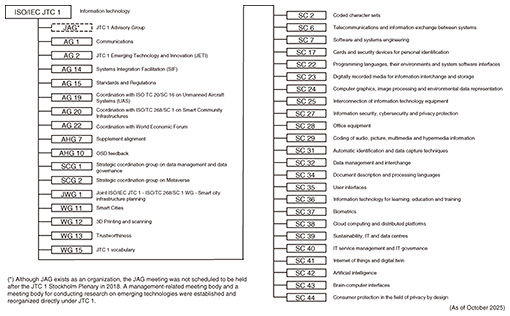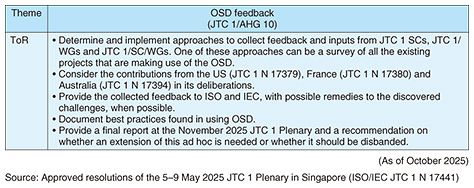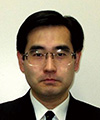 |
|||||||||||||||
|
|
|||||||||||||||
|
Global Standardization Activities Vol. 23, No. 11, pp. 86–89, Nov. 2025. https://doi.org/10.53829/ntr202511gls Technical Trends in ISO/IEC Joint Technical Committee 1AbstractThe International Organization for Standardization (ISO)/International Electrotechnical Commission (IEC) Joint Technical Committee (JTC) 1 is an organization established by ISO and IEC and is responsible for international standardization in the field of information technology. This article introduces the activities being addressed by subgroups directly under JTC 1, which were identified in resolutions from recent ISO/IEC JTC 1 Plenaries. Keywords: ISO/IEC JTC 1, Plenary, Advisory Group 1. IntroductionThe International Organization for Standardization (ISO)/International Electrotechnical Commission (IEC) Joint Technical Committee (JTC) 1 [1] was established by ISO [2] and IEC [3] and is responsible for the international standardization of information technology. Formerly, ISO/Technical Committee (TC) 97 (established in 1960) and IEC/TC 53 (established in 1961) independently promoted standardization activities in the information-technology field, resulting in the duplication of certain technical fields between these organizations [4]. JTC 1 was established in 1987 to solve this problem. The secretariat of JTC 1 is the American National Standards Institute (ANSI). As of October 2025, JTC 1 comprises 49 P-members (active participants) and 57 O-members (observers). The Plenary is JTC 1’s highest decision-making meeting, and the main agenda is as follows:
2. Organization of ISO/IEC JTC 1The organization of JTC 1 is shown in Fig. 1. The development of standards is carried out by 24 SCs, 4 WGs, and 1 Joint Working Group (JWG) directly under JTC 1. Discussions on management issues, such as the review of operational rules, and on technology issues, such as examination of issues with a view to development of future standards, are carried out by AGs, Ad-hoc Groups (AHGs), and Strategic Coordination Groups (SCGs) under JTC 1. JTC 1 has established liaisons with organizations other than JTC 1, including IEC/TC 65 (Industrial-process measurement, control, and automation), IEC/TC 100 (Audio, video, and multimedia systems and equipment), ISO/TC 215 (Health informatics), ISO/TC 307 (Blockchain and distributed ledger technologies), IEC/ISO JTC 3 (Quantum technologies), ITU-T (International Telecommunication Union - Telecommunication Standardization Sector), and Ecma International.
The activities and deliverables of WG 14 (Quantum information technology), which used to be directly under JTC 1, were transferred to JTC 3 in 2024. Though a resolution was approved to establish a new SC on smart cities under JTC 1 at the JTC 1 Paestum Plenary in May 2023, ISO/IEC JTC 4 (Smart and sustainable cities and communities) was established this year (in 2025), following discussions between the management boards of ISO and IEC. The activities and deliverables of the organizations deliberating on smart cities under ISO, IEC, and JTC 1, such as ISO/TC 268/SC 1 (Smart community infrastructures), IEC/SyC Smart Cities, and JTC 1/WG 11, are expected to be transferred to JTC 4. Japan has been in an important position regarding the management of JTC 1 as follows:
JTC 1 Plenary has been held twice a year (spring and fall) since 2019. The four most recent JTC 1 Plenaries were held in Berlin (Germany) in November 2023, Darwin (Australia) in May 2024, Seoul (South Korea) in November 2024 and Singapore in May 2025. At these Plenaries, Japan has greatly contributed to steering JTC 1 by proposals through more than 20 contributions and participation in the Drafting Committee. The following sections introduce several trends in JTC 1 subgroups and activities for JTC 1 in the Japanese National Body (NB)*1.
3. Latest trends in JTC 1 subgroups3.1 Launch of SC on consumer protection by privacy by designAs shown in Fig. 1, SC 44 (Consumer protection by privacy by design) is the most recently established within JTC 1. The establishment of SC 44 originated by a proposal from ISO/COPOLCO (Committee on consumer policy) to convert ISO PC (Project Committee) 317, which handles ISO 31700 series (Privacy by design for consumer goods and services), into a TC to maintain these documents. In response to this proposal, ISO/TMB (Technical Management Board) decided to transfer the responsibility to JTC 1 rather than establishing a new TC within ISO and recommended that JTC 1 establish a new SC to allocate ISO 31700 series within JTC 1. At JTC 1 Darwin Plenary in May 2024, there was a great deal of discussion regarding the organizational structure following this recommendation. Japanese NB proposed that the activities related to consumer privacy should be allocated to the current SC 27 (Information security, cybersecurity and privacy protection) rather than creating a new SC, with concerns about the dispersion of experts related to privacy. As a result of the discussion, the ideas creating a new SC accounted for the majority. At JTC 1 Seoul Plenary in November 2024, a resolution was approved to establish SC 44, including its title and scope as discussed by AHG on shaping the future of consumer protection and privacy topics within JTC 1. Approved by both ISO/TMB and IEC/SMB (Standardization Management Board), SC 44 began its activities with its first Plenary held in April 2025. SC 44 is chaired by Jan Schallaböck (Germany), and the British Standards Institution (BSI) serves as Secretariat. 3.2 Feedback on Online Standards DevelopmentOnline Standards Development (OSD) provides the technical community with a unique and harmonized platform for developing standards online, collaboratively, from the preliminary stage through to publication. Since January 2025, OSD has become the default tool for ISO and IEC standards development. OSD has the advantage that committee members can focus on the content of the draft as ISO/IEC Directives are reflected in the tool and reach consensus easily with their collaborative work. However, issues on OSD have arisen. At JTC 1 Singapore Plenary in May 2025, a resolution was approved for JTC 1 to establish AHG on OSD feedback (AHG 10) to collect and send feedback to ISO/IEC Central Office regarding OSD issues and operational improvements. AHG 10 is chaired by Sal Francomacaro (US), and its Terms of Reference (ToR) is indicated in Table 1.
3.3 For a healthy generational change of WGsAlthough current ISO/IEC Directives stipulate that the term of the WG convenor is up to three years, there is no limit to the number of terms. To promote a generational change of WGs, AHG on succession planning (AHG 8) developed a guidance document that provides best practices for succession planning for JTC 1 subgroups within the constraints of the current ISO/IEC Directives, according to the resolution at JTC 1 Berlin Plenary in November 2023. At JTC 1 Singapore Plenary in May 2025, the deliverables submitted by AHG 8 (Guidance document - ISO/IEC JTC 1 Succession Planning) were confirmed, and AHG 8 disbanded. Each SC and WG directly under JTC 1 is thereafter required to submit a succession planning report considering this Guidance for every JTC 1 fall Plenary, according to the recommended table of contents. 4. Activities in Japanese NBIn Japan, SCs under JTC 1 and WGs/JWG/AGs/AHGs directly under JTC 1 are mainly operated by Information Technology Standards Commission of Japan (ITSCJ)*2 [5]. Each mirror committee for WG 11/JWG 1, WG 12, WG 13, and WG 15 directly under JTC 1 has been established in ITSCJ to share the status of deliberations and address international ballots. Since 2018, JTC 1 Subgroup Subcommittee has been active in ITSCJ, which comprehensively addresses the issues that the AGs are required to participate in as NB. JTC 1 Subgroup Subcommittee shares deliberations of each AG and discusses how to deal with AGs. This Subcommittee also addresses standardization items for SC 43 (Brain-computer interfaces). In ITSCJ, mirror committee for SC 44 has been established as “SC 44 Subcommittee” under the mirror committee for SC 27. Subcommittee for Directives is also active in ITSCJ, as Japanese companies and organizations other than the members of JTC 1/AG 15 and JTC 1/AHG 7 are highly interested in ISO/IEC Directives.
5. Future PlenariesThe upcoming Plenaries will be held in Chengdu (China) in November 2025 and in São Paulo (Brazil) in May 2026. References
|
|||||||||||||||











